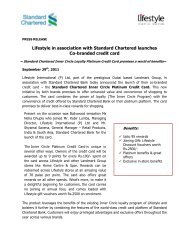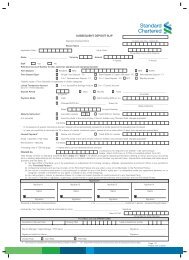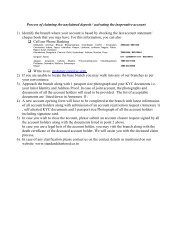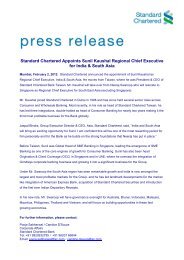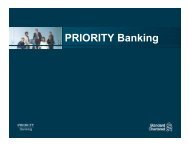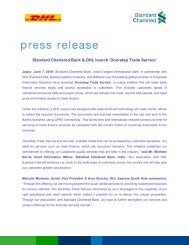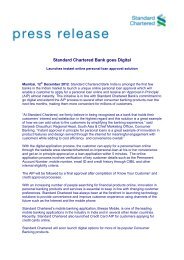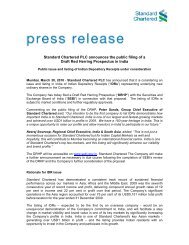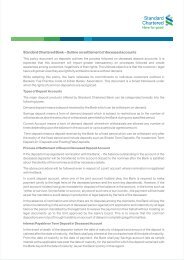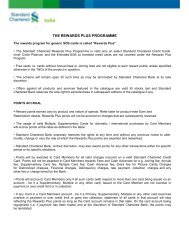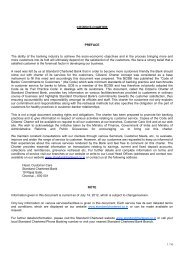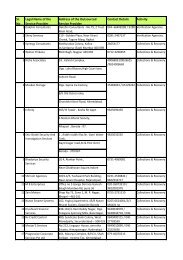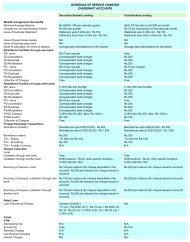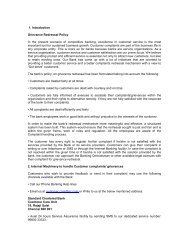March 12 - Standard Chartered Bank
March 12 - Standard Chartered Bank
March 12 - Standard Chartered Bank
You also want an ePaper? Increase the reach of your titles
YUMPU automatically turns print PDFs into web optimized ePapers that Google loves.
Risk review and disclosures under Basel II Framework for the year ended 31 <strong>March</strong> 20<strong>12</strong><br />
The <strong>Bank</strong> uses the Basic Indicator Approach consistent with the RBI’s capital adequacy requirements to assess its<br />
regulatory capital requirements for operational risk. Under the Basic Indicator Approach, a pre-determined beta<br />
co-efficient is applied to the average income for the previous three years, to determine the operational risk<br />
capital requirement.<br />
10. OTHER KEY RISKS<br />
10.1. Liquidity Risk<br />
Liquidity risk is the potential that the <strong>Bank</strong> either does not have sufficient liquid financial resources available to<br />
meet all its obligations and commitments as they fall due, or can only access these financial resources at<br />
excessive cost.<br />
The Liquidity Risk Framework governs liquidity risk and is managed by ALCO. In accordance with the framework,<br />
the <strong>Bank</strong> maintains a liquid portfolio of marketable securities as reserve assets. The level of the <strong>Bank</strong>’s aggregate<br />
liquid reserves is in accordance with local regulatory minimum liquidity requirements.<br />
10.2. Reputational Risk<br />
Reputational risk is the potential for damage to the franchise, resulting in loss of earnings or adverse impact on<br />
market capitalisation as a result of stakeholders taking a negative view of the organisation or its actions. It is<br />
Group/<strong>Bank</strong> policy that it will protect its reputation and not undertake any activities that may cause material<br />
damage to its franchise.<br />
The Reputational Risk Policy governs reputational risk and is managed by the MANCO through its subcommittees<br />
– CRC and CORC, which has the responsibility to ensure that the <strong>Bank</strong> does not undertake any<br />
activities that may cause material damage to the Group’s franchise.<br />
Reputational risk is recorded and reviewed by the Country Head of Corporate Affairs, and key issues are flagged<br />
to the CRC and relevant Business heads. Reputational risk is reported to the CEO through the CRC. Whilst the<br />
CRC covers all forms of risk in country, key reputational risk is also discussed and escalated to Group<br />
Communications Management team. Corporate Affairs representatives sit on CORC and CRC. Monthly reporting<br />
from Corporate Affairs to Group Communications Management team is in place to ensure that significant risks<br />
are duly escalated. A fast track reporting process outside the normal reporting process is in place to respond to<br />
ad hoc issues or events which pose potential reputational risk to the <strong>Bank</strong>. The process involves alerting the<br />
appropriate level of the <strong>Bank</strong> and the Group promptly to give as much time as possible for steps to be taken to<br />
limit damage to its reputation.<br />
11. MONITORING<br />
Monitoring of risk management is achieved through independent reviews by Risk Control Owners, Group<br />
Internal Audit (GIA), Compliance & Monitoring, concurrent audits and spot checks by the external specialists as<br />
required under regulations. The role of GIA is defined and overseen by the Board Audit Committee.<br />
To ensure the effectiveness of risk management processes in maintaining the risk profile of the <strong>Bank</strong> within risk<br />
appetite, the <strong>Bank</strong> maintains three ‘lines of defence’. Each ‘line of defence’ describes a specific set of<br />
responsibilities for risk management and control. Under this framework, there are three lines of defence.<br />
30



